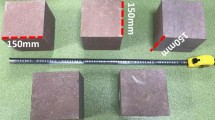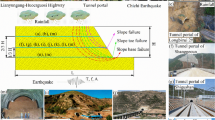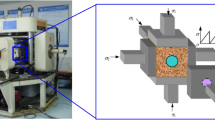Abstract
Seismic force is one of the main factors resulting in the slip failure of steep rock slopes. In this paper, the seismic displacement analysis of rock slopes is carried out by virtue of the kinematical theorem of limit analysis and the Newmark method. It is assumed that the slope has a curvilinear cone-shaped failure mechanism and its materials are subjected to the Hoek-Brown failure criterion. The generalized tangential technique is employed to obtain equivalent parameters from the Hoek-Brown criterion. According to the three-dimensional failure mechanism, the internal energy dissipation and external work are respectively calculated, and the effect of horizontal seismic force is included by using the equivalent pseudo-static method. Subsequently, the yield acceleration is calculated for three-dimensional failure mechanism, and the results are shown to be valid when compared with the previous solutions. Parameter analysis is used to represent how the Hoek-Brown criterion parameters impact on the yield acceleration. The failure mechanism is also obtained during the process of limit analysis, and a dimensionless coefficient is adopted to investigate the influence of it on the seismic displacements of slopes. The results of calculations are given for a series of actual seismic waves and compared with the results calculated from empirical formula.
Similar content being viewed by others
References
Amiri, F., Anitescu, C., Arroyo, M., Bordas, S. P., and Rabczuk, T. (2014). “XLME interpolants, a seamless bridge between xfem and enriched meshless methods.” Computational Mechanics, Vol. 53, No. 1, pp. 45–57, DOI: 10.1007/s00466-013-0891-2.
Areias, P., Msekh, M. A., and Rabczuk, T. (2016a). “Damage and fracture algorithm using the screened poisson equation and local remeshing.” Engineering Fracture Mechanics, Vol. 158, pp. 116–143, DOI: 10.1016/j.engfracmech.2015.10.042.
Areias, P. and Rabczuk, T. (2017). “Steiner-point free edge cutting of tetrahedral meshes with applications in fracture.” Finite Elements in Analysis and Design, Vol. 132, pp. 27–41, DOI: 10.1016/j.finel.2017.05.001.
Areias, P., Rabczuk, T., and Camanho, P. P. (2014). “Finite strain fracture of 2D problems with injected anisotropic softening elements.” Theoretical and Applied Fracture Mechanics, Vol. 72, pp. 50–63, DOI: 10.1016/j.tafmec.2014.06.006.
Areias, P., Rabczuk, T., and Dias-Da-Costa, D. (2013). “Element-wise fracture algorithm based on rotation of edges.” Engineering Fracture Mechanics, Vol. 110, No. 3, pp. 113–137, DOI: 10.1016/j.engfracmech.2013.06.006.
Areias, P., Rabczuk, T., and Msekh, M. A. (2016b). “Phase-field analysis of finite-strain plates and shells including element subdivision.” Computer Methods in Applied Mechanics and Engineering, Vol. 312, pp. 322–350, DOI: 10.1016/j.cma.2016.01.020.
Areias, P., Reinoso, J., Camanho, P. P., Sá, J. C. D., and Rabczuk, T. (2017). “Effective 2D and 3D crack propagation with local mesh refinement and the screened poisson equation.” Engineering Fracture Mechanics, DOI: 10.1016/j.engfracmech.2017.11.017.
Ausilio, E. and Zimmaro, P. (2015). “Displacement-based seismic design of a shallow strip footing positioned near the edge of a rock slope.” International Journal of Rock Mechanics and Mining Sciences, Vol. 76, No. 7, pp. 68–77, DOI: 10.1016/j.ijrmms.2015.02.010.
Bray, J. D. and Rathje, E. M. (1998). “Earthquake-induced displacements of solid-waste landfills.” Journal of Geotechnical and Geoenvironmental Engineering, Vol. 124, No. 3, pp. 242–253, DOI: 10.1061/(ASCE) 1090-0241(1998)124:3(242).
Chang, C. J., Chen, W. F., and Yao, J. T. (1984). “Seismic displacements in slopes by limit analysis.” Journal of Geotechnical Engineering, Vol. 110, No. 7, pp. 860–874, DOI: 10.1061/(ASCE)0733-9410(1984) 110:7(860).
Chen, W. F. and Liu, X. L. (1990). “Limit analysis in soil mechanics.” Elsevier Science, Amsterdam.
Cong, S., Tang, L., Ling, X., Geng, L., and Lu, J. (2018). “Boundary effect on the seismic response of a three-dimensional soil slope with a shallow foundation on top.” KSCE Journal of Civil Engineering, Vol. 22, No. 4, pp. 1130–1140, DOI: 10.1007/s12205-017-1535-4.
Crespellani, T., Madiai, C., and Vannucchi, G. (1998). “Earthquake destructiveness potential factor and slope stability.” Géotechnique, Vol. 48, No. 3, pp. 411–419, DOI: 10.1680/geot.1998.48.3.411.
He, Y., Hazarika, H., Yasufuku, N., Yasufuku, N., Han, Z., and Li, Y. (2015). “Three-dimensional limit analysis of seismic displacement of slope reinforced with piles.” Soil Dynamics and Earthquake Engineering, Vol. 77, pp. 446–452, DOI: 10.1016/j.soildyn.2015.06.015.
Hoek, E., Carranze-Torres, C., and Corkum, B. (2002). “Hoek-Brown failure criterion-2002 edition.” Proceedings of NARMS-Tac, pp. 267–273. Retrieved (https://doi.org/photo.jlwu.idv.tw/~enggeo/rocklaboratory/101/HOEK-BROWN.pdf).
Hsieh, S. Y. and Lee, C. T. (2011). “Empirical estimation of the Newmark displacement from the Arias intensity and critical acceleration.” Engineering Geology, Vol. 122, No. 1, pp. 34–42, DOI: 10.1016/j.enggeo.2010.12.006.
Jafarian, Y. and Lashgari, A. (2016). “Simplified procedure for coupled seismic sliding movement of slopes using displacement-based critical acceleration.” International Journal of Geomechanics, Vol. 16, No. 4, DOI: 10.1061/(ASCE)GM.1943-5622.0000578.
Lim, K., Lyamin, A. V., Cassidy, M. J., and Li, A. J. (2016). “Threedimensional slope stability charts for frictional fill materials placed on purely cohesive clay.” International Journal of Geomechanics, Vol. 16, No. 2, DOI: 10.1061/(ASCE)GM.1943-5622.0000526.
Li, E., Zhuang, X., Zheng, W., and Cai, Y. (2014). “Effect of graph generation on slope stability analysis based on graph theory.” Journal of Rock Mechanics and Geotechnical Engineering, Vol. 6, No. 4, pp. 380–386, DOI: 10.1016/j.jrmge.2014.05.003.
Li, T. Z. and Yang, X. L. (2018a). “Reliability analysis of tunnel face in broken soft rocks using improved response surface method.” International Journal of Geomechanics, Vol. 18, No. 5, DOI: 10.1061/(ASCE)GM.1943-5622.0001129.
Li, T. Z. and Yang, X. L. (2018b). “Risk assessment model for water and mud inrush in deep and long tunnels based on normal grey cloud clustering method.” KSCE Journal of Civil Engineering, Vol. 22, No. 5, pp. 1991–2001, DOI: 10.1007/s12205-017-0553-6.
Li, Z.W. and Yang, X. L. (2018c). “Active earth pressure for soils with tension cracks under steady unsaturated flow conditions.” Canadian Geotechnical Journal, DOI: 10.1139/cgj-2017-0713.
Mankelow, J. M. and Murphy, W. (1998). “Using GIS in the probabilistic assessment of earthquake triggered landslide hazards.” Journal of Earthquake Engineering, Vol. 2, No. 2, pp. 593–623, DOI: 10.1080/13632469809350336
Marinos, P. and Hoek, E. (2000). “GSI: A geologically friendly tool for rock mass strength estimation.” Proc. GeoEng2000 Conference, Melbourne, Retrieved (https://doi.org/www.geoplanning.it/test/wp-content/uploads/2012/02/GSI.pdf).
Marinos, P. and Hoek, E. (2001). “Estimating the geotechnical properties of heterogeneous rock masses such as Flysch.” Bulletin of Engineering Geology and the Environment, Vol. 60, No. 2, pp. 85–92, DOI: 10.1007/s100640000090.
Michalowski, R. L. and Drescher, A. (2009). “Three-dimensional stability of slopes and excavations.” Géotechnique, Vol, 59, No. 10, pp. 839–850, DOI: 10.1680/geot.8.P.136.
Michalowski, R. L. and Martel, T. (2011). “Stability charts for 3D failures of steep slopes subjected to seismic excitation.” Journal of geotechnical and geoenvironmental engineering, Vol. 137, No. 2, pp. 183–189, DOI: 10.1061/(ASCE)GT.1943-5606.0000412.
Nadukuru, S. S. and Michalowski, R. L. (2013). “Three-dimensional displacement analysis of slopes subjected to seismic loads.” Canadian Geotechnical Journal, Vol. 50, No. 6, pp. 650–66, DOI: 10.1139/cgj-2012-0223.
Newmark, N. M. (1965). “Effect of earthquakes on dams and embankments.” Géotechnique, Vol. 15, No. 2, pp. 139–160, DOI: 10.1680/geot.1965.15.2.139.
Rabczuk, T. and Belytschko, T. (2004). “Cracking particles: A simplified meshfree method for arbitrary evolving cracks.” International Journal for Numerical Methods in Engineering, Vol. 61, No. 13, pp. 2316–2343, DOI: doi.org/10.1002/nme.1151.
Rabczuk, T., Zi, G., Bordas, S., and Nguyen-Xuan, H. (2010). “A simple and robust three-dimensional cracking-particle method without enrichment.” Computer Methods in Applied Mechanics and Engineering, Vol. 199, Nos. 37–40, pp. 2437–2455, DOI: 10.1016/j.cma.2010.03.031.
Ren, H., Zhuang, X., and Rabczuk, T. (2017). “Dual-horizon peridynamics: A stable solution to varying horizons.” Computer Methods in Applied Mechanics and Engineering, Vol. 318, pp. 762–782, DOI: 10.1016/j.cma.2016.12.031.
Ren, H., Zhuang, X., Cai, Y., and Rabczuk, T. (2016). “Dual-horizon peridynamics.” International Journal for Numerical Methods in Engineering, Vol. 108, No. 12, pp. 1451–1476, DOI: 10.1002/nme.5257.
Saada, Z., Maghous, S., and Garnier, D. (2011). “Seismic bearing capacity of shallow foundations near rock slopes using the generalized Hoek-Brown criterion.” International Journal for Numerical and Analytical Methods in Geomechanics, Vol. 35, No. 6, pp. 724–748, DOI: 10.1002/nag.929.
Vu-Bac, N., Lahmer, T., Zhuang, X., Nguyen-Thoi, T., and Rabczuk, T. (2016). “A software framework for probabilistic sensitivity analysis for computationally expensive models.” Advances in Engineering Software, Vol. 100, pp. 19–31, DOI: 10.1016/j.advengsoft.2016.06.005.
Saygili, G. and Rathje, E. M. (2008). “Empirical predictive models for earthquake-induced sliding displacements of slopes.” Journal of Geotechnical and Geoenvironmental Engineering, Vol. 134, No. 6, pp. 790–803, DOI: 10.1061/(ASCE)1090-0241(2008)134:6(790).
Xu, J. S. and Yang, X. L. (2018). “Effects of seismic force and pore water pressure on three dimensional slope stability in nonhomogeneous and anisotropic soil.” KSCE Journal of Civil Engineering, Vol. 22, No. 5, pp. 1720–1729, DOI: 10.1007/s12205-017-1958-y.
Xu, J. S., Li, Y. X., and Yang, X. L. (2018). “Seismic and static 3D stability of two-stage slope considering joined influences of nonlinearity and dilatancy.” KSCE Journal of Civil Engineering, DOI: 10.1007/s12205-018-0636-z.
Yang, X. L. (2002). Limit analysis method and its application to geotechnical engineering with linear and nonlinear failure criteria, PhD thesis, Central South University, Changsha, China. 2002.
Yang, X. L. (2007). “Seismic displacement of rock slopes with nonlinear Hoek-Brown failure criterion.” International Journal of Rock Mechanics and Mining Sciences, Vol. 44, No. 6, pp. 948–953, DOI: 10.1016/j.ijrmms.2007.01.002.
Zheng, W., Zhuang, X., Tannant, D. D., Cai, Y., and Nunoo, S. (2014). “Unified continuum/discontinuum modeling framework for slope stability assessment.” Engineering Geology, Vol. 179, pp. 90–101, DOI: 10.1016/j.enggeo.2014.06.014.
Zhuang, X., Wang, Q., and Zhu, H. (2017). “Multiscale modelling of hydro-mechanical couplings in quasi-brittle materials.” International Journal of Fracture, Vol. 204, No. 1, pp. 1–27, DOI: 10.1007/s10704-016-0139-1.
Author information
Authors and Affiliations
Corresponding author
Rights and permissions
About this article
Cite this article
Li, Y., Yang, X. Three-dimensional Seismic Displacement Analysis of Rock Slopes based on Hoek-Brown Failure Criterion. KSCE J Civ Eng 22, 4334–4344 (2018). https://doi.org/10.1007/s12205-018-3022-y
Received:
Revised:
Accepted:
Published:
Issue Date:
DOI: https://doi.org/10.1007/s12205-018-3022-y




